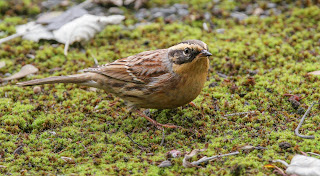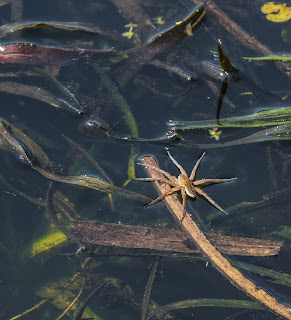Sunday 16 October 2016
Spurn ~ 14 October
A thoroughly enjoyable day, the highlight of which was undoubtedly the Siberian Accentor (UK325) opposite the Easington Gas Terminal.
A walk down the point was profitable with a self-found and very showy Dusky Warbler along with SEO, 30+ Mealy Redpoll, 20 Ring Ouzel, 10 Woodcock, Little Gull, 100 WF Geese, 2 Bean Geese. Perhaps most impressive was the fall of thrushes and finches across the spit, including 60+ Brambling on the beach.
Thursday 30 June 2016
New Forest ~ 30 June
A day spent in the New Forest with 2 primary targets: Bog Orchid & pumilio. The former was out in reasonable numbers at the usual site near Stoney Cross.

A trip to Mill Lawn Brook was unproductive with high water levels eliminating any chance of pumilio and just one mercuriale was found. Onto Latchmore Brook where pumilio were out in force with approximately 150 on the two usual flushes 1mile or so east of the main car park. These included ~8 aurantiaca. Just 6 mercuriale were found - it appears to have been a very poor year for this species.

A trip to Mill Lawn Brook was unproductive with high water levels eliminating any chance of pumilio and just one mercuriale was found. Onto Latchmore Brook where pumilio were out in force with approximately 150 on the two usual flushes 1mile or so east of the main car park. These included ~8 aurantiaca. Just 6 mercuriale were found - it appears to have been a very poor year for this species.
Sunday 26 June 2016
Thursley Common & Hankley Common ~ 19 June, 20 June & 26 June
2 visits to new areas of Thursley Common away from the popular Moat Car Park. Effort was concentrated towards the southern end, where mosaic-style management seems to be a lot more prominent and consequently the area is a lot more biodiverse.
Dartford Warbler, Woodlark, Tree Pipit & Redstart are all in good numbers, the latter appearing to have had a particularly good year.
Silver-studded Blues are thinly distributed with the exception of one dense population on the western edge. A ~50m transect yielded 48. Numbers of Bombus lucorum across the site are very impressive along with smaller numbers of hypnorum & terrestris.
Ammophila wasps were abundant and consequently one lone Mottled Bee-fly (Thyridanthrax fenestratus) was found on my latter visit.
A trip to Hankley Common Golf Course on the 20th June was notable for 1 Mottled Bee-fly but most impressively for Textrix denticulata, seemingly a first for Surrey and a very rare sighting in the SE of England.
Dartford Warbler, Woodlark, Tree Pipit & Redstart are all in good numbers, the latter appearing to have had a particularly good year.
Silver-studded Blues are thinly distributed with the exception of one dense population on the western edge. A ~50m transect yielded 48. Numbers of Bombus lucorum across the site are very impressive along with smaller numbers of hypnorum & terrestris.
 |
| Bombus lucorum (M) |
 |
| Silver-studded Blue |
Ammophila wasps were abundant and consequently one lone Mottled Bee-fly (Thyridanthrax fenestratus) was found on my latter visit.
 |
| Mottled Bee-fly ~ Thyridanthrax fenestratus |
A trip to Hankley Common Golf Course on the 20th June was notable for 1 Mottled Bee-fly but most impressively for Textrix denticulata, seemingly a first for Surrey and a very rare sighting in the SE of England.
Friday 17 June 2016
Warren Heath/Garden ~ 17 June
First trip of the year was a success with a teneral metallica (my earliest ever) among extremely good numbers of patrolling Downy Emeralds (Cordulia aenea). Keeled Skimmer numbers are building but are some way off their peak. Small-red numbers were noticeably lower than at other sites - the site certainly seems to have deteriorated over the past few years.
A nice surprise upon return to the garden with a Hylaeus confufus nesting in some holes on a concrete fence post (photographed here with a nectar/pollen mix used to fill the nest).
A nice surprise upon return to the garden with a Hylaeus confufus nesting in some holes on a concrete fence post (photographed here with a nectar/pollen mix used to fill the nest).
Wednesday 15 June 2016
East Blean Woods ~ 15 June
A trip to East Blean Woods in search of Heath Fritillaries parking here and exploring the clearings nearby. Following a heavy rain shower, the humidity was high which brought out a dozen or so fritillaries which favoured vegetation >1m in length. During periods of sunny weather their flight was strong and flicking, but immediately became inactive and approachable during periods of cloud.
The only other butterflies seen at the site were 1 Red Admiral, 2 Holly Blue & 1 Speckled Wood.
2 Green-eyed (Norfolk) Hawker were a nice surprise, presumably dispersing from nearby Westbere Marshes, and good numbers of hoverflies were making use of the coppiced clearings, including several of the impressive Volucella inflata.
A brief trip to Westbere Marshes on the way home found another couple of Green-eyed Hawker and this female Hairy Dragonfly feeding on a bee.
The only other butterflies seen at the site were 1 Red Admiral, 2 Holly Blue & 1 Speckled Wood.
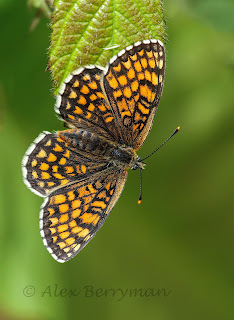 |
| Heath Fritillary ~ Melitaea athalia |
 | |
|
 |
| Volucella inflata |
 |
| Green-eyed Hawker - Aeshna isoceles |
Sunday 5 June 2016
Holt CP ~ 6 June
A quick visit to Holt CP where the highlight was a single Broad-bordered Bee Hawk-moth. A rather tatty Green Hairstreak was also a nice find on the ride behind the car park, along with a couple of Hairy Dragonflies & Holly Blues.
A single, rather sorrowful-looking Bird's Nest Orchid was found along with a couple of Common Twayblade.
A single, rather sorrowful-looking Bird's Nest Orchid was found along with a couple of Common Twayblade.
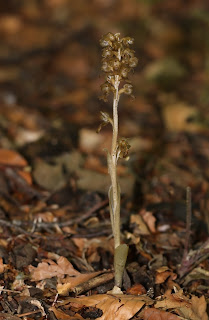 |
| Bird's Nest Orchid |
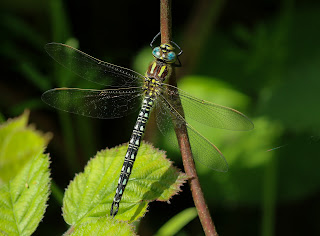 |
| Hairy Dragonfly (M) |
Saturday 4 June 2016
Carlton Marshes ~ 4 June
My first visit to this rather special reserve in the south-eastern corner of the broads. I accessed the southern section via public transport (train to Oulton Broad) here. The northern section would certainly be worthy of a visit too.
Following the track north, a smaller path to the left running alongside a dyke looked promising. As the clouds parted and the temperature began to rise at least 6 Fen Raft Spider (Dolomedes plantarius) began to hunt (primarily ovipositing Variable Damselflies with a very poor success rate).
In terms of Odonata, the site was spectacular, with densities I have only ever seen in the acidic bogs of the New Forest. Variable Damselflies were the most numerous with only small numbers of Azure. Interestingly this population was seemingly very homogenous, with all males observed (200+) looking like classic 'fieldguide' individuals.
A small number of Scarce Chasers were by the dyke first thing, but as Hairy Dragonfly numbers began to build, they soon dispersed away from the water.
I had predicted that if the weather forecast was correct, Norfolk Hawkers could begin to emerge and indeed at just after 1 p.m, I found 2 very fresh-looking tenerals.
Following the track north, a smaller path to the left running alongside a dyke looked promising. As the clouds parted and the temperature began to rise at least 6 Fen Raft Spider (Dolomedes plantarius) began to hunt (primarily ovipositing Variable Damselflies with a very poor success rate).
In terms of Odonata, the site was spectacular, with densities I have only ever seen in the acidic bogs of the New Forest. Variable Damselflies were the most numerous with only small numbers of Azure. Interestingly this population was seemingly very homogenous, with all males observed (200+) looking like classic 'fieldguide' individuals.
 |
| Coenagrion pulchellum |
A small number of Scarce Chasers were by the dyke first thing, but as Hairy Dragonfly numbers began to build, they soon dispersed away from the water.
 |
| Brachytron pratense |
I had predicted that if the weather forecast was correct, Norfolk Hawkers could begin to emerge and indeed at just after 1 p.m, I found 2 very fresh-looking tenerals.
 |
| Anaciaeshna isosceles |
Monday 30 May 2016
Military Orchids - Brecks ~ 30 May
Went to see Military Orchids flowering at a well-known site in the Suffolk Brecks which holds over 95% of the UK population of this extremely rare species in Britain. This was my first time seeing this species; they were slightly larger than I had expected and most stunning, despite the pretty miserable weather.
 |
| Military Orchid ~ Orchis militaris |
 |
| Military Orchid ~ Orchis militaris |
Thursday 26 May 2016
Goring & Hartslock ~ 26 May
A trip to the well-known concrete bank here where the railway crosses the River Thames south of Goring.
Arriving at around 0915, there was a Common Clubtail halfway through emerging on the bank - very lucky indeed. A series of photos of the emergence is shown below.
Walking along the Thames to the East, the warm weather encouraged good numbers of Banded Demoiselles, and a female Peregrine circled overhead. Arriving at Hartlock at around 11:30am, there were large numbers of Monkey x Lady Orchid in bloom along with considerably smaller number of Monkey Orchid. No Lady Orchid were present.
Arriving at around 0915, there was a Common Clubtail halfway through emerging on the bank - very lucky indeed. A series of photos of the emergence is shown below.
 |
| Common Clubtail ~ Gomphus vulgatissimus |
 |
| Common Clubtail ~ Gomphus vulgatissimus |
 |
| Common Clubtail ~ Gomphus vulgatissimus |
 |
| Common Clubtail ~ Gomphus vulgatissimus |
Walking along the Thames to the East, the warm weather encouraged good numbers of Banded Demoiselles, and a female Peregrine circled overhead. Arriving at Hartlock at around 11:30am, there were large numbers of Monkey x Lady Orchid in bloom along with considerably smaller number of Monkey Orchid. No Lady Orchid were present.
 |
| Monkey x Lady Orchid ~ Orchis x angusticruris
|
 |
| Monkey Orchid ~ Orchis Simia |
 | |
|
Across the down Dingy Skippers were out in good numbers, along with a few Green Hairstreak and a lone but surprisingly fresh Grizzled Skipper. A good number of Nomada goodeniana were around and a couple of chalkland specialists including Osmia bicolor and Hoplitis claviventris.
 |
| Hoplitis claviventris |
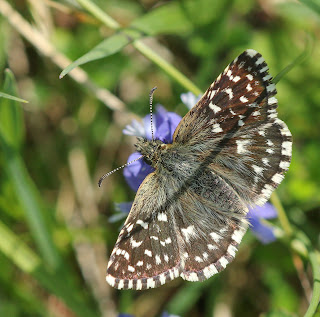 |
| Grizzled Skipper ~ Pyrgus malvae |
Thursday 19 May 2016
UEA ~ 19 May
An afternoon walk along the section of river running through UEA-land from the Watersoldier pond to the playing fields bridge. Odonata counts were:
1 Red-eyed Damselfly (ten.)
~80 Banded Demoiselle (inc. some emerging)
5 Blue-tailed Damselfly
45 Azure Damselfly
17 Common Blue
~50 Large Reds
1 t.male Black-tailed Skimmer
1 Hairy Dragonfly
1 Red-eyed Damselfly (ten.)
~80 Banded Demoiselle (inc. some emerging)
5 Blue-tailed Damselfly
45 Azure Damselfly
17 Common Blue
~50 Large Reds
1 t.male Black-tailed Skimmer
1 Hairy Dragonfly
 |
| Eristalis horticola |
Saturday 14 May 2016
UEA ~ 14 May
A very quick walk around patch this afternoon was rewarded with excellent views of a male Cuckoo feeding alongside the river to the west of the broad. A second male was singing from within the rabbit enclosure.
Numbers of Nomad bees continue to build in the small clearing to the west of the broad, along with good numbers of Andrena haemorrhoa (females identifiable by the brick red pile on the top of the thorax, orange hairs to the tip of the abdomen and yellow hind tibia) nesting in the bare patches of soil.
Numbers of Nomad bees continue to build in the small clearing to the west of the broad, along with good numbers of Andrena haemorrhoa (females identifiable by the brick red pile on the top of the thorax, orange hairs to the tip of the abdomen and yellow hind tibia) nesting in the bare patches of soil.
 |
| Andrena haemorrhoa |
Wednesday 6 April 2016
Altea ~ 30 March - 6 April 2016
A very basic trip report from a holiday that was not focussed on birds/birding but nonetheless yielded some good species. Flights to Alicante were cheap, and I was based in the small town of Pueblo Mascarat on the outskirts of Altea, approximately an hour's drive to the north-east of Alicante.
Although not a birder's typical destination, the area holds a number of sites that are very promising and certainly worthy of further explanation if you find yourself in this region.
Pueblo Mascarat
This hillside town was surprisingly decent with Blue Rock Thrush and 4+ Black Wheatear pairs breeding in the town, the latter regularly performing song-flights from villas and lamposts.
There are large numbers of Pallid Swift breeding, and before temperatures increased large congregations would regularly feed over the town, often accompanied by Common Swifts and small numbers of Alpine Swift and Crag Martin, the latter two breeding on the steep slope by the road-tunnel that heads towards Calp.
Serin, Firecrest & Sardinian Warbler were abundant (as they are everywhere in these parts) though Black Redstart, Woodchat Shrike & Hoopoe were surprisingly scarce. Nightingales breed in the bottom of the dried-river valley and the area generally looks good for migrants that follow the coastline northwards.
Geranium Bronze were seen in the dried river valley along with good numbers of European Swallowtail & Cleopatra.
Calp
2 sites of interest in this town, the Les Salines saltpans no doubt being the star attraction. Large congregations of 200+ Greater Flamingo and 80+ Black-winged Stilt offer great views from the circular footpath that circumnavigates the waters edge. This area looks amazing for migrants with very good scrapes for passage waders (only LRP on my visit), and the reeds towards the western edge most likely hold Great Reed Warbler etc. Slender-billed Gull appear to be regular. A flock of Little Egret held Cattle Egret and a single Glossy Ibis, and a flock of Whiskered Tern flew through on one visit. Definitely a site worthy of exploration.
Ifach Rock holds a large (Yellow-legged) gull colony and Black Wheatear and Blue Rock Thrush breed on the steep slope. The small area of scrub at the tip of the point is again no doubt a good area for migrants, and also holds breeding Sardinian and Western Subalpine Warbler.
Later in the year, this site reportedly has breeding Eleonora's Falcon, though I failed to find any recent, reliable reports of this species.
Altea
Where the river (Riu de l'Algar) meets the sea at Altea as marked here there is a small reed-edged pool. The reedbeds hold Little Bittern , and Purple Heron are likely to feed along the river itself (with one individual seen circling for 15 mins).
Audouin's Gull breed nearby and come down to bread. This is a site worth exploring with a record of Baillon's Crake in April 2015 and regular local reports of Squacco Heron.
Purple Swamphens are the 'star attraction' with at least 6 showing well at all times of day, regularly feeding on bread that had drifted into the reedbeds, and when quiet venturing onto the beach.
Large numbers of hirundines roost in the reedbeds during migration, including Red-rumped Swallow.
Although not a birder's typical destination, the area holds a number of sites that are very promising and certainly worthy of further explanation if you find yourself in this region.
Pueblo Mascarat
This hillside town was surprisingly decent with Blue Rock Thrush and 4+ Black Wheatear pairs breeding in the town, the latter regularly performing song-flights from villas and lamposts.
There are large numbers of Pallid Swift breeding, and before temperatures increased large congregations would regularly feed over the town, often accompanied by Common Swifts and small numbers of Alpine Swift and Crag Martin, the latter two breeding on the steep slope by the road-tunnel that heads towards Calp.
Serin, Firecrest & Sardinian Warbler were abundant (as they are everywhere in these parts) though Black Redstart, Woodchat Shrike & Hoopoe were surprisingly scarce. Nightingales breed in the bottom of the dried-river valley and the area generally looks good for migrants that follow the coastline northwards.
Geranium Bronze were seen in the dried river valley along with good numbers of European Swallowtail & Cleopatra.
 |
| Black Wheater |
 |
| Redstart |
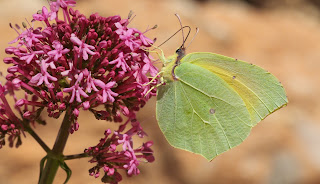 |
| Cleopatra |
2 sites of interest in this town, the Les Salines saltpans no doubt being the star attraction. Large congregations of 200+ Greater Flamingo and 80+ Black-winged Stilt offer great views from the circular footpath that circumnavigates the waters edge. This area looks amazing for migrants with very good scrapes for passage waders (only LRP on my visit), and the reeds towards the western edge most likely hold Great Reed Warbler etc. Slender-billed Gull appear to be regular. A flock of Little Egret held Cattle Egret and a single Glossy Ibis, and a flock of Whiskered Tern flew through on one visit. Definitely a site worthy of exploration.
Ifach Rock holds a large (Yellow-legged) gull colony and Black Wheatear and Blue Rock Thrush breed on the steep slope. The small area of scrub at the tip of the point is again no doubt a good area for migrants, and also holds breeding Sardinian and Western Subalpine Warbler.
Later in the year, this site reportedly has breeding Eleonora's Falcon, though I failed to find any recent, reliable reports of this species.
 |
| Black-winged Stilt |
 |
| Little Ringed Plover |
 |
| Greater Flamingo |
 |
| 'Iberian' Yellow Wagtail |
Altea
Where the river (Riu de l'Algar) meets the sea at Altea as marked here there is a small reed-edged pool. The reedbeds hold Little Bittern , and Purple Heron are likely to feed along the river itself (with one individual seen circling for 15 mins).
Audouin's Gull breed nearby and come down to bread. This is a site worth exploring with a record of Baillon's Crake in April 2015 and regular local reports of Squacco Heron.
Purple Swamphens are the 'star attraction' with at least 6 showing well at all times of day, regularly feeding on bread that had drifted into the reedbeds, and when quiet venturing onto the beach.
Large numbers of hirundines roost in the reedbeds during migration, including Red-rumped Swallow.
 |
| Audouin's Gull |
 |
| Purple Swamphen |
 |
| Purple Heron |
 |
| Red-rumped Swallow |
Subscribe to:
Posts (Atom)


